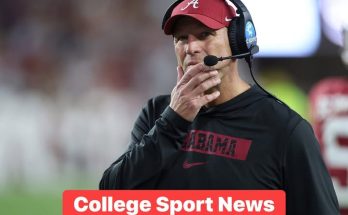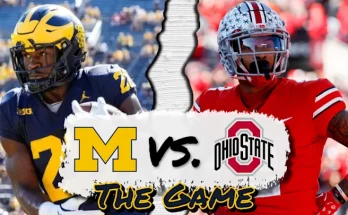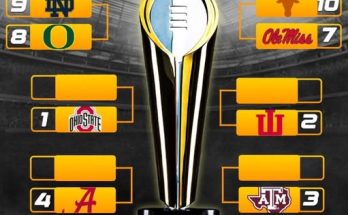The Los Angeles Lakers have found themselves navigating the intricate financial waters of the NBA once again, and this time it revolves around the mid-level exception (MLE) space available to them after the recent signing of Jake LaRavia. With LaRavia’s addition, the Lakers now have approximately \$8.25 million left in their MLE, a valuable piece of cap space that could prove instrumental as they eye the possibility of adding a significant name like Deandre Ayton via the buyout market. The team’s maneuvering in this regard reveals much about their current strategy, their short-term ambitions, and the broader challenges faced by one of the league’s most storied franchises as they attempt to climb back to championship contention.
The MLE, a vital tool for NBA teams operating above the salary cap, allows franchises to sign players for a set amount without needing cap space to match that salary. After the Lakers inked Jake LaRavia, a promising young forward, they were left with about \$8.25 million from their available MLE. This amount is not insignificant but also not vast enough to sign multiple impactful veterans without additional moves. The allocation of this remaining MLE will play a pivotal role in shaping the roster’s final composition for the coming season.
Jake LaRavia, who the Lakers recently signed, is a versatile player with the potential to develop into a key rotational piece. Drafted in the 2023 NBA Draft, LaRavia offers the Lakers length, athleticism, and a burgeoning skill set that aligns with the team’s desire to build a competitive supporting cast around their core stars. His contract, absorbed through the MLE, demonstrates the Lakers’ commitment to blending youthful potential with experienced talent. This signing, while a positive step in talent accumulation, also tightens the financial leash on the front office, emphasizing the importance of careful budgeting going forward.
The remaining \$8.25 million in the MLE positions the Lakers as active players in the buyout market, a domain that has become increasingly important in the modern NBA. The buyout market allows teams to acquire veteran players who have been waived by their previous clubs, usually at a reduced salary and outside the conventional salary cap restrictions. These signings can provide significant upside, often bringing in seasoned contributors eager to compete for a championship.
Among the names linked to the Lakers’ interest is Deandre Ayton, a player whose potential acquisition could bring both size and skill to the Lakers’ frontline. Ayton, a former number one overall draft pick, has shown flashes of dominance as a rim protector and an efficient scorer in the paint. However, his career has been somewhat marred by inconsistency and questions about his fit in certain team systems. For the Lakers, signing Ayton via the buyout market would be a calculated gamble, hoping that a change of scenery and the chance to play alongside established stars can reignite his trajectory.
Ayton’s fit with the Lakers would address a critical need for interior presence and rebounding. In recent years, the Lakers have struggled to maintain a dominant inside game, especially on the defensive end. Adding Ayton could help shore up this weakness, allowing the team’s perimeter defenders more freedom and reducing the burden on the wings. Furthermore, Ayton’s ability to roll to the basket and finish in traffic would complement the Lakers’ pick-and-roll schemes, providing additional offensive diversity.
Of course, the Lakers must weigh the potential upside of an Ayton signing against the financial realities they face. The \$8.25 million MLE is not an unlimited resource; it must be managed wisely to ensure the Lakers retain flexibility for the remainder of the season. Beyond salary considerations, roster spots and team chemistry are also vital factors in any potential signing.
The Lakers have historically been aggressive in leveraging exceptions like the MLE to bolster their roster, especially during championship windows. Their willingness to invest in veteran talent while maintaining cap flexibility has been a hallmark of their strategy in recent years. However, this approach requires precise balancing to avoid cap pitfalls that could hinder future moves. The remaining MLE after LaRavia’s signing presents both an opportunity and a challenge in this respect.
One key aspect of the Lakers’ financial management in this period is the emphasis on buyout savings. Players who are bought out by their previous teams often accept reduced salaries to join contenders, enabling teams like the Lakers to sign quality veterans at a fraction of their market value. This mechanism has proven fruitful in the past, bringing in impact players who contribute immediately. By carefully managing their MLE space and leveraging buyout savings, the Lakers aim to maximize value in what remains a competitive offseason market.
The current NBA landscape makes this strategy even more crucial. With a league-wide salary cap that has grown but remains relatively flat compared to escalating player demands, teams like the Lakers must be savvy in their spending. The combination of LaRavia’s developmental promise and the prospect of adding a proven contributor like Ayton reflects a nuanced approach to roster construction, blending youth and experience while operating within tight financial constraints.
Moreover, the Lakers’ front office and coaching staff are acutely aware that adding players is not solely about the contract figures but also about how these players fit into the team’s culture and playing style. The Lakers have a storied history of team-first players who accept roles and contribute beyond just individual statistics. Any potential signing, including Ayton, must mesh with this ethos to foster cohesion and success on the court.
Another dimension to consider is the Lakers’ relationship with star players and how new signings might impact locker room dynamics. Bringing in a big-name veteran like Ayton could energize the squad but also requires careful handling to ensure roles are clear and expectations aligned. The front office’s ability to navigate these interpersonal elements will be as important as their financial decisions.
As the Lakers explore their MLE options and eye a potential Ayton deal, they must also remain mindful of other roster needs. Depth at guard, wing scoring, and defensive versatility are all areas that might require attention. The limited MLE space left after LaRavia’s signing means prioritizing the most impactful additions is essential. This could mean that some positions remain untouched or that the team opts for smaller contracts to preserve future flexibility.
Additionally, the Lakers’ salary cap situation is further complicated by existing contracts and luxury tax implications. While the MLE allows for some spending beyond the cap, exceeding luxury tax thresholds can lead to significant financial penalties. The Lakers have been known to absorb such costs in pursuit of championship aspirations, but there is always a delicate balance to maintain between aggressive spending and long-term sustainability.
In the context of the NBA’s evolving financial rules and player movement trends, the Lakers’ current scenario underscores the importance of strategic cap management. With the trade deadline and buyout periods approaching, the team must remain nimble, ready to pivot based on available opportunities and changing circumstances. The remaining \$8.25 million in MLE could be the key to unlocking a late-season roster boost that shifts the competitive landscape in their favor.
Looking beyond just the financial and tactical elements, the Lakers’ pursuit of an Ayton signing and efficient use of their MLE space also speaks to their broader ambition to reclaim their status as title contenders. After recent years of ups and downs, the organization is keen to assemble a roster capable of competing at the highest level. The combination of young talent like LaRavia and experienced veterans acquired via the buyout market fits into a vision of sustained success.
the Los Angeles Lakers’ position with \$8.25 million left in their mid-level exception following the signing of Jake LaRavia presents a strategic crossroads. Their potential interest in adding Deandre Ayton via the buyout market represents a calculated effort to bolster their interior presence and overall roster depth. Balancing this ambition with the realities of salary cap constraints, luxury tax considerations, and team chemistry will be critical in determining the success of these moves. As the NBA season unfolds, the Lakers’ ability to leverage their remaining MLE wisely and capitalize on buyout savings could prove decisive in their quest to return to championship glory. The organization’s blend of youthful promise and veteran experience positions them well to adapt and thrive in a highly competitive league environment. Fans and analysts alike will be watching closely to see how these financial and roster strategies unfold in the coming weeks, with the hope that the Lakers can once again ascend to the pinnacle of NBA success.



